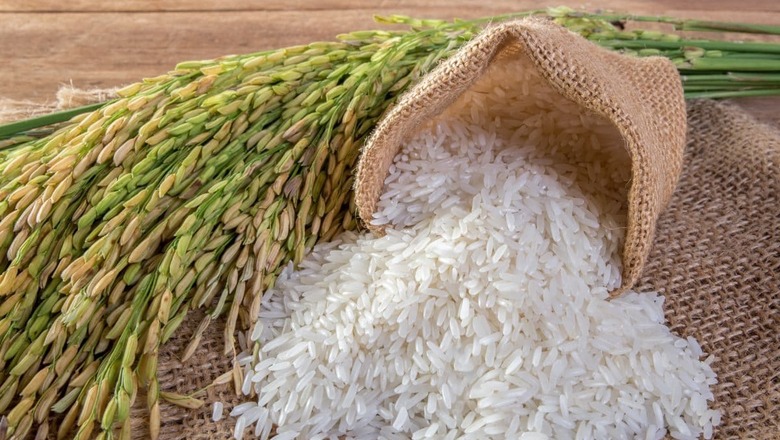
views
Rice, dal, a vegetable medley and fish curry was standard fare for Bengal’s urban middle class at the turn of the last century. Halfway through the 20th century came chapatis. Rare was the Bengali household that mastered the art of making soft chapatis but nevertheless they replaced rice for dinner in countless homes across India at the time and Bengalis also valiantly masticated them to contribute to the government’s effort to reach foodgrain to the poorest Indians.
And by foodgrain, the government of the day meant wheat and rice, of course and production was far from adequate to feed all Indians though the population was one-fourth of today’s. Eventually it led India to the west with a begging bowl and the humiliating grant of wheat from the US under its PL 480 proviso, called ‘Ship to Mouth’ existence. It proved to be a double boon for the US: a way to dispose of excess wheat and get concessions from ‘aided’ hungry nations.
The upshot of this was the famed Green Revolution of the 1960s — with the help of the US agronomist Norman Borlaug, Ford and Rockefeller Foundations of course — as India and many other ‘Third World’ nations still could not produce enough wheat and rice to feed everyone. But did Indians need to be provided only wheat and rice — imported or hybridised for high yield — rather than any of the traditional, less water guzzling indigenous grains such as millets?
In a presentation in the Nehru Library this week, Dr Saumya Gupta spoke about the measures to combat national hunger in the early years after independence where the focus was on controlling individual consumption rather than increasing production, admittedly a rather novel policy stance. It included setting up Annapurna Canteens that offered meals without rice and wheat, rationing and even ‘miss a meal’ schemes. But they all had minimal success.
She said that the Nehru government was also determined to follow a ‘scientific’ approach to food and cooking, getting people to change their dietary preferences. The idea was to provide subsidiary foods, which led to the setting up of the Central Food Technological Research Institute in Mysore. Differently written cookbooks and home science teachers were also part of the movement to make wheat and rice skewed Indian diets healthier and ‘scientific’.
The invisible elephant in Dr Gupta’s presentation, however, was millets. Wheat never went down well in the east. Southern India was equally underwhelmed. There was a famous cartoon at the time featuring a south Indian gentleman holding a chapati and asking if wheat is used to make glue too. Millets were already part of the southern diet, and also healthy. So why was it not promoted instead of wheat? Were policies implemented without thought?
The generations that parented the birth of independent India were not known for excessive consumption. Barring the miniscule elite comprising princely scions, zamindars, nobility, a few business families and maybe top professionals, Indians were mostly frugal. The salaried class at all levels had large families (including hangers-on) to feed, clothe, educate and marry off, so everything was adequate rather than in abundance. Why impose even more austerity on them?
Meals were measured for India’s middle and lower middle class: grain depended on the region, vegetables depended on the season, and legumes, fish and meat depended on finances. This class was also literate in varying degrees and had a professional association with colonial rulers. They thus imbibed many of their prejudices. Crucially, that included favouring wheat and rice over ‘coarse’ grains. Then after Independence they were ordered to forgo those!
Not many Indians know that in 1949-50, the same time that Prime Minister Jawaharlal Nehru’s government was focusing on controlling consumption of wheat and rice, small millets (a ‘coarse grain) were being cultivated in 8 million hectares of India. So why did that figure fall in succeeding decades, reaching 1.8 million hectares in 2017-18, although millets used far less water and were an obvious alternative to wheat and rice as they are just as nutritious?
Aspirations can be directed, even controlled. When Britain consolidated its rule in India, it also changed cultivation habits in India, making farmers produce cash crops like cotton, indigo and tobacco rather than food grain. They also percolated their ideas of fine and coarse grains to the middle class, making wheat and rice paramount. Repeated famines, as much due to drought as mismanagement during the Raj also made hunger and starvation permanent spectres.
That said, rationing and miss-a-meal immediately after Independence could hardly be successful as nothing was wasted or left over in urban Indian homes. Judging from Dr Gupta’s research, which comprised official data from urban areas, the government (and its British-era bureaucrats) overlooked the innate frugality of India’s middle class while pushing austerity. Then they went in for western wheat and rice technologies to increase foodgrain production.
Via the Green Revolution Indian farmers got access to high-yielding rice and wheat varieties from Mexico and Philippines (where the Ford and Rockefeller Foundations were aiding this renaissance) driving their cultivation in even non-conventional areas. With the added lure of subsidised fertilisers, dams and canals increasing water availability and the government providing low cost rice and wheat, India obediently followed the western logic of hunger alleviation.
But the popularity of rawa or wheat semolina idli (reportedly created in the late 1940s by Bengaluru’s Mavalli Tiffin Rooms) and now rawa dosa and upma are proof that Indians do accept new grains. Even Bengal grew a millet called ‘ka’un’ which was wrongly also classified as a ‘chaal’ (rice in Bengali) and used to make milk payesh in winter right up to the early decades of the 20th century. They may have used more had this grain been more ‘aspirational’.
Imagine how much water, pesticides and fertilizer subsidies may have been saved in the last 75 years if Nehru’s government had considered introducing innovative millet dishes across India. Instead the PM grew sweet potatoes and other vegetables, bananas, maize and even millets within Teen Murti House’s vast compound and supported doomed food innovations such as tapioca macaroni, mixed ‘nutro’ flour and ground nut milk for urban Indians.
Today’s Indians waste far more than the previous generations. We are still slaves of the wheat and rice duopoly while professing concern about falling water tables as well as rising diabetes and gluten allergies! Millets invite condescension or incomprehension now as young Indians know more about quinoa and couscous now. It is time Indians realise their folly and explore India’s traditional foods rather retain or adopt aspirational diets from elsewhere.



















Comments
0 comment